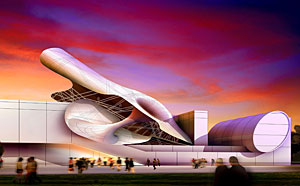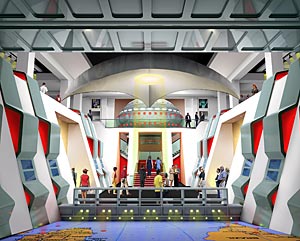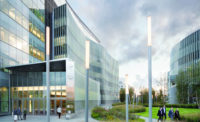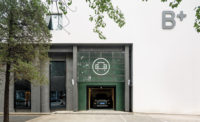UFO Museum Has Close Encounter of the CAD Kind
Have intelligent beings from other planets visited Earth? The International UFO Museum and Research Center, in Roswell, New Mexico, lacks a definitive answer, such as an alien spacecraft—but it does have plenty of intriguing photographs and affidavits from people who say they have seen one. “If visitors walk out of here with more questions than they had when they came in, that’s all we ask,” says executive director Julie Shuster.


Ahearn-Schopfer Associates, a Boston-based firm, is designing a new home for the International UFO Museum and Research Center, in Roswell, New Mexico.
In designing a new home for the institution, Kevin Schopfer, AIA, a principal of Boston-based Ahearn-Schopfer Associates, also sought to arouse curiosity. Although his 18,000-square-foot, one-story building features a rectangular footprint and mostly rectilinear concrete volumes, a warped plane cants from the west elevation and soars nearly 90 feet above the main entry. This surface, which will likely be gel-coated fiberglass, folds over on itself while a funnel-shaped hole connects the top and bottom facets.
“The concept is that this is a found object emerging from a file cabinet, kind of like information hidden in a drawer somewhere,” Schopfer explains, referring to the purported government cover-up of extraterrestrial evidence. “It’s meant to grab your attention and question what it is.”
The funnel represents a wormhole, he continues, which some physicists hypothesize is a shortcut between distant parts of the universe—and that ufologists believe extraterrestrials use to visit Earth. It’s a billboard building that “entices people from the roadway,” Schopfer admits, but it avoids the ubiquitous alien and UFO iconography common in Roswell, an isolated desert town whose name is synonymous with the alleged crash of a flying saucer there in July 1947.
What the museum lacks on its exterior it will contain inside. A large mock-up of a flying disc will hang from the ceiling in the lobby. It’s this “iconic moment” that visitors will remember afterward, hopes Penny Sander, senior associate and project manager at Cambridge Seven Associates, based in Cambridge, Massachusetts, which is designing the exhibits.
Chances are there will be many visitors. Annual attendance has grown from 3,000, when the museum opened in 1992, to more than 160,000—one reason why it has already moved twice into bigger accommodations. It is now raising $15 million for construction of the new building and hopes to break ground in early 2009; later phases might include a 30- to 40-room boutique hotel.
Schopfer learned that the museum needed a new home while watching a TV program about the Roswell crash. The project allowed him to pursue his interests in architecture and outer space. “UFOs make a great story,” he says, “and the subject matter is really endless.”




Post a comment to this article
Report Abusive Comment